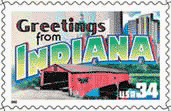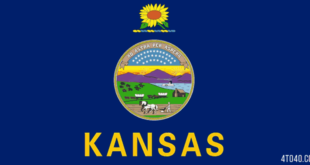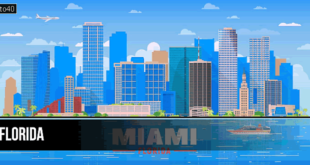 Indiana, one of five eastern north central states, Indiana is bordered on the west by Illinois, on the north by Michigan and Lake Michigan, and on the east by Ohio. The Ohio River follows Indiana’s southern border with Kentucky. The state is rectangular in shape, and its capital, Indianapolis, lies near its center. Indiana has an extreme length of 451 km (280 mi) and a breadth of 257 km (160 mi), giving it an area that makes it the 38th largest state.
Indiana, one of five eastern north central states, Indiana is bordered on the west by Illinois, on the north by Michigan and Lake Michigan, and on the east by Ohio. The Ohio River follows Indiana’s southern border with Kentucky. The state is rectangular in shape, and its capital, Indianapolis, lies near its center. Indiana has an extreme length of 451 km (280 mi) and a breadth of 257 km (160 mi), giving it an area that makes it the 38th largest state.
Indiana was part of the early Northwest Territory; it became a state in 1816. Its name recalls the inhabitants at the time of first colonial exploration in 1679. The nickname “Hoosier State” is thought to be derived from the pioneers’ greeting to strangers, “Who’s yere?”
Indiana has a large, accessible market. It is located near several large metropolitan areas in neighboring states. Its Great Lakes and Ohio River ports, along with its major highways, provide Indiana with access to much of the nation.
Land & Resources
 Indiana has three distinct natural regions: the northern lakes, the central plains, and the southern hills and valleys. The sand dunes along Lake Michigan are considered by many to be the most scenic feature of the northern region. The central plains are flat or gently rolling, but the Wabash River and some of its tributaries have dissected the western part of the state, creating slopes and valleys. The southern hills are primarily limestone. Weathering has resulted in the formation of caves, sinkholes, underground streams, and mineral springs. Along the Ohio River, the bluffs are rugged and scenic.
Indiana has three distinct natural regions: the northern lakes, the central plains, and the southern hills and valleys. The sand dunes along Lake Michigan are considered by many to be the most scenic feature of the northern region. The central plains are flat or gently rolling, but the Wabash River and some of its tributaries have dissected the western part of the state, creating slopes and valleys. The southern hills are primarily limestone. Weathering has resulted in the formation of caves, sinkholes, underground streams, and mineral springs. Along the Ohio River, the bluffs are rugged and scenic.
All of Indiana except the south central portion was glaciated. Deposits of clay, sand, gravel, and boulders filled the preglacial valleys, and deep and fertile soils, primarily gray brown podzols, have developed. Under the till is stratified limestone, shale, and sandstone.
Climate
Indiana’s continental climate is characterized by hot, humid summers and cold and moist winters. January mean temperatures range from 2 deg C (35 deg F) in Evansville to minus 4 deg C (25 deg F) in South Bend. July temperatures at the same locations are 26 deg C (78 deg F) and 23 deg C (73 deg F), respectively.
Major temperature variations are caused by differences in latitude, elevation, terrain, and–in winter–by the lake effect. Moisture is picked up from Lake Michigan by air masses moving across it. When the warmer moisture-laden air moves over the colder shore surface, it loses its ability to hold water vapor, resulting in the state’s heaviest snowfalls.
The growing season varies from 160 days in the north to 178 days in the south. Annual precipitation averages 864 mm (34 in) in the north and 1,118 mm (44 in) along the Ohio River. Most precipitation is caused by continental air masses mixing with humid tropical air masses from the Gulf of Mexico.
Wildlife
During the early years of settlement, wilderness life was threatened by commercial hunters and farmers, who cleared the land for agriculture. Bear, buffalo, deer, and wolves disappeared from the area. Smaller game species were also threatened.
During the 1880s, Indiana pioneered in the enactment of environmental-protection legislation. Today, among the larger animals, only the deer have been replenished. Small animals, namely cottontail rabbits, raccoon, fox, and opossum, have increased in number, however. The populations of grouse and wild turkey have also grown as have those of the fish in Indiana streams.
Tourism
Indiana has an abundance of forests, lakes, sand dunes, and pleasant landscapes, as well as national, state, and county parks, state memorials, historical sites, and museums.
The state’s fields and forests are hospitable to a variety of wildlife. There is deer hunting and the limited hunting of wild turkey. Natural and artificial bodies of water support normal growth of fish populations and fish hatcheries for bass, bluegill, crappie, and catfish. Lake Michigan, under careful guidance, is returning as a fishing site. Many fish are caught from ponds formed in abandoned strip mines.
The Indiana Dunes National Lakeshore in the north preserves the beach shore of Lake Michigan. Brown County State park is well known for its fall foliage and for the artist colonies in its vicinity. Wyandotte Cave in Harrison County is one of the nation’s largest. West Baden Springs near the Hoosier National Forest has mineral springs, and nearby French Lick draws many visitors each year for sports, mineral baths, and relaxation. In the past two decades several ski resorts have developed. Historic Indian sites are found at Mounds State park near Anderson and Angel Mounds near Evansville. Other tourist attractions include historic Vincennes, Abraham Lincoln’s boyhood home in Spencer County, and the restored communal settlement at New Harmony.
History
Archaeologists now recognize Indian village sites and constructions in Indiana as evidence of habitation by ancient MOUND BUILDERS. Mounds State Park in Madison County preserves some remnants of their past. Most spectacular of the archaeological finds is the Angel Mound site near Evansville. At least seven mounds have been identified within the Ohio River flood plain. The largest “beehive” has provided more than a million cataloged artifacts since its discovery in 1939. Centuries of habitation by the MIAMI, POTAWATOMI, DELAWARE, and KICKAPOO Indian tribes made little change in the natural environment of Indiana.
The first European exploration of present-day Indiana was in 1679 by Robert Cavelier, Sieur de LA SALLE, who attempted to establish French military domination over the Mississippi region. French Jesuit priests founded the first permanent European settlement, VINCENNES, in 1725. The French traders bargained for furs, and the Jesuits pursued their missionary work.
Even as late as 1800 most of what is now Indiana was recognized as Indian territory. The arrival of the colonists brought on a period of violence between the settlers and the Indian inhabitants. Friendly secessions from white occupied areas began in the late 1700s. The best known of the Indian land transfers was the New Purchase of 1818 that opened the bulk of Indiana to the whites.
Before statehood Indiana had several administrative centers. Vincennes became a French fort in 1732, about 50 years after colonial trading began. The British controlled Vincennes from 1763 until 1779, when George Rogers CLARK, financially aided by Governor Patrick Henry of Virginia, seized the fort for the Americans.
In 1784, Virginia relinquished its claim to the NORTHWEST TERRITORY. Indiana Territory was created in 1800 and included what was to become the states of Indiana, Illinois, and Wisconsin, along with parts of Michigan and Minnesota. Indiana’s boundaries have changed little since it became a state.
The Battle of TIPPECANOE in 1811 effectively broke the power of Indian tribes in the territory. Indiana was admitted to the Union in 1816, the second state formed from the Northwest Territory. Corydon, the first state capital, was superseded in 1825 by Indianapolis, which had been designed as the seat of state government. Communities began to form in the territory as statehood approached. New Harmony along the Wabash was the site chosen for George Rapp’s Harmony Society and by Robert OWEN for his cultural and scientific commune.
Indiana’s first railroad was begun in 1834, connecting Indianapolis to the Ohio at Madison, the state’s largest city in 1847. The rail line fostered economic growth and provided access to European markets for Indianapolis through the Mississippi River system. The National Road gave rise to numerous highway junctions that become thriving communities.
Canal and railroad construction left a permanent mark on state government. By publicly funding these projects, the state approached bankruptcy. State indebtedness was forbidden by the 1851 constitution. All governmental agencies are required to have balanced budgets at the end of each fiscal year.
One Confederate raid in 1863, led by General John Hunt MORGAN, was the only significant incident to take place in Indiana during the Civil War. The state backed the Union efforts despite the Southern origins of many residents. Abraham Lincoln had spent his boyhood in Spencer County, Ind., and many Hoosiers considered him a native son worthy of support.
Farming, mining, and forestry developed after the Civil War. One of the oldest industries in the state produced sandstone grinding wheels and honing stones. European immigrants to Indiana provided skills that diversified the industry of the state: glassmaking, furniture manufacturing, and brick and tile making. Laborers from the industrial centers of Europe settled in the Calumet region, lured there by employment opportunities in the steel mills and foundries.
Today, Indiana maintains a diverse economy. Although farming is declining in importance relative to manufacturing and service industries, it remains a significant sector of the economic life of the state. The state’s inland location makes adequate transportation critical. Despite protests by environmentalists, Burns Harbor–the Port of Indiana–was constructed on Lake Michigan to serve oceangoing vessels, thus underscoring the priority status given to commerce in the Indiana economy.
Land
- Area: 94,328 sq km (36,420 sq mi); rank: 38th.
- Capital and largest city: Indianapolis (1990 pop., 741,952).
- Counties: 92.
- Elevations: highest–383 m (1,257 ft), in Franklin Township; lowest–98 m (320 ft), at the Ohio River.
 Kids Portal For Parents India Kids Network
Kids Portal For Parents India Kids Network









